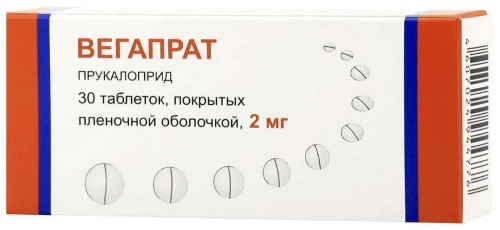No products in the cart.
Description
Prucalopride is indicated for the symptomatic treatment of chronic constipation in women in whom laxatives have not provided sufficient relief of symptoms.
Composition
Composition
Composition per tablet:
Active substance:
Prucalopride succinate 2.642 mg in terms of prucalopride 2.000 mg
Excipients:
Microcrystalline cellulose, sodium carboxymethyl starch, magnesium stearate, colloidal silicon dioxide.
Shell: hypromellose 6 CP, macrogol 6000, titanium dioxide, talc.
Contraindications
Contraindications
– Hypersensitivity to the active component or any of the excipients.
– Impaired renal function requiring dialysis.
– Bowel perforation or obstruction due to anatomical or functional abnormalities of the bowel wall, mechanical intestinal obstruction, severe bowel inflammation such as Crohn’s disease, ulcerative colitis and toxic megalon/megarectum.
Carefully
The use of the drug in patients with severe and clinically unstable concomitant diseases (renal, pulmonary, cardiovascular, neurological, endocrine diseases, mental disorders, cancer, AIDS) has not been studied. Caution should be exercised when prescribing Prucalopride to patients with a history of cardiac arrhythmia or ischemic heart disease.
Use during pregnancy and breastfeeding
Experience with the use of prucalopride during pregnancy is limited. Cases of miscarriage have been reported in clinical studies, although given the presence of other risk factors, the connection between these events and the use of prucalopride remains unproven. Animal studies have not revealed direct or indirect adverse effects on the course of pregnancy, embryonic/fetal development, parturition, or postnatal development of the offspring. The drug is not recommended for use during pregnancy. During treatment with prucalopride, women of childbearing potential should use adequate contraception.
Prucalopride is excreted in breast milk, however, when used in therapeutic doses, the drug is unlikely to have an effect on newborns/infants. Due to the lack of data on use in nursing mothers, the drug is not recommended for use during breastfeeding.
Animal studies have not revealed any effect of the drug on the fertility of males or females.
Special instructions
Special instructions
In severe diarrhoea, the effectiveness of oral contraceptives may be reduced and it is recommended to use additional contraceptive methods to prevent a decrease in the effectiveness of oral contraceptives (see instructions for use of oral contraceptives).
Impaired liver function is unlikely to have a clinically significant effect on the metabolism and systemic exposure of prucalopride in humans. There are no data on the use of the drug in patients with mild, moderate or severe liver impairment, therefore a lower dose is recommended for patients with severe liver impairment.
No rebound effect or dependence was observed for prucalopride. A study of the effect of prucalopride on the QT interval at therapeutic (2 mg) and supratherapeutic (10 mg) doses showed no significant differences compared with placebo in terms of QT interval values. The incidence of QT-related adverse events and ventricular arrhythmias was low and comparable to that seen with placebo.
Impact on the ability to drive vehicles or operate machinery
Caution should be exercised when driving a vehicle or operating moving machinery, as dizziness and weakness may occur, especially in the first days of treatment.
Drug interactions
Drug interactions
In vitro data indicate that prucalopride has little interaction potential and is unlikely to interfere with the cytochrome P450 enzyme-mediated metabolism of coadministered drugs at therapeutic concentrations. Although prucalopride may bind weakly to P-glycoprotein (P-gp), it does not inhibit P-gp activity at clinically relevant concentrations.
The potent CYP3A4 and P-gp inhibitor ketoconazole 200 mg twice daily increased the AUC of prucalopride by approximately 40%. This effect is too small to be clinically significant and is most likely due to inhibition of the active renal transport of prucalopride by P-gp. The same interactions seen with ketoconazole may also occur with other P-gp inhibitors, such as verapamil, cyclosporine A, and quinidine. Prucalopride is also most likely transported in the kidney by other transporters. Theoretically, inhibition of all transporters involved in the active renal secretion of prucalopride (including P-gp) could increase its systemic exposure by 75%.
Studies in healthy volunteers have shown no clinically significant effect of prucalopride on the pharmacokinetics of warfarin, digoxin, ethyl alcohol, and paroxetine. When prucalopride and erythromycin are coadministered, the plasma concentration of erythromycin increases by 30%. The mechanism of this interaction is not fully understood, but the available data indicate that it is most likely not the result of a direct effect of prucalopride, but a consequence of the high variability in the pharmacokinetics of erythromycin itself.
Probenecid, cimetidine, erythromycin and paroxetine at therapeutic doses did not affect the pharmacokinetics of prucalopride.
No interactions with food were detected.
Pharmacodynamics
Pharmacodynamics
Prucalopride is a dihydrobenzofurancarboxamide that increases intestinal motility. Prucalopride is a selective, high-affinity 5HT4 serotonin receptor agonist, which most likely explains its action on intestinal motility. Binding to other receptor types in vitro was observed only at concentrations of the substance exceeding its affinity for 5HT4 receptors by at least 150 times.
Storage temperature
Storage temperature
from 2℃ to 25℃
Pharmacokinetics
Pharmacokinetics
Prucalopride is rapidly absorbed; after a single oral dose of 2 mg, the maximum concentration (Cmax) is reached in 2-3 hours. Absolute bioavailability after oral administration exceeds 90%. Taking the drug with food does not affect bioavailability.
Prucalopride is distributed throughout the body, the volume of distribution at steady state is 567 L. Plasma protein binding is approximately 30%.
In vitro metabolism of the drug in the human liver is very slow, with only a small number of metabolites formed. Following oral administration of 14C-labeled prucalopride to humans, 8 metabolites are detected in urine and faeces in small amounts. The major metabolite (R107504, formed by O-demethylation of prucalopride and oxidation of the resulting alcohol to a carboxylic acid) accounts for less than 4% of the administered dose. Radiolabeled studies have shown that approximately 85% of the drug remains unchanged; the metabolite R107504 is present in plasma in small amounts.
Most of an orally administered dose of the active component is excreted unchanged (approximately 60% via the urine and at least 6% via the feces). Renal excretion of unchanged prucalopride involves passive filtration and active secretion. Plasma clearance of prucalopride averages 317 mL/min, with a terminal half-life of approximately 24 hours. Steady-state is achieved within 3-4 days of dosing, with steady-state minimum and maximum plasma concentrations of 2.5 and 7 ng/mL, respectively, following once-daily dosing. The k-factor for once-daily dosing ranges from 1.9 to 2.3. Prucalopride pharmacokinetics are linearly dependent on dose up to 20 mg/day. With long-term once-daily dosing, its pharmacokinetics are independent of the duration of dosing.
Pharmacokinetics in specific patient groups
Population pharmacokinetics
Population pharmacokinetic analysis showed that total body clearance of prucalopride correlates with creatinine clearance (CrCl) and is independent of age, body weight, gender, or race of patients.
Elderly patients
When the drug was administered to elderly patients at a dose of 1 mg once a day, the maximum concentration of prucalopride in the blood plasma (Cmax) and the area under the concentration/time curve (AIJC) were 26% and 28% higher, respectively, than in younger patients. This difference may be due to the weakening of renal function in the elderly.
Impaired renal function
Compared with patients with normal renal function, in patients with mild (CrCl 50-79 ml/min) and moderate (CrCl 25-49 ml/min) renal impairment, plasma prucalopride concentrations after a single 2 mg dose were increased by 25% and 51%, respectively. In patients with severe renal impairment (CrCl less than 24 ml/min), plasma prucalopride concentrations were 2.3 times higher than in healthy individuals.
Impaired liver function
Approximately 35% of prucalopride is eliminated extrarenally, so liver dysfunction is unlikely to significantly alter the pharmacokinetics of the drug.
Children
Following a single oral dose of 0.03 mg/kg prucalopride in children aged 4-12 years, the Cmax of the drug was similar to that observed after a 2 mg dose in adults, and the AUC of the unbound fraction of the drug was 30-40% lower than in adults and was not dependent on the age of the children. The mean terminal half-life of the drug in children is approximately 19 hours (range 11.6-26.8 hours).
Other forms…
Related products
Buy Vegaprat 2 mg 30 pcs with delivery to USA, UK, Europe and over 120 other countries.










